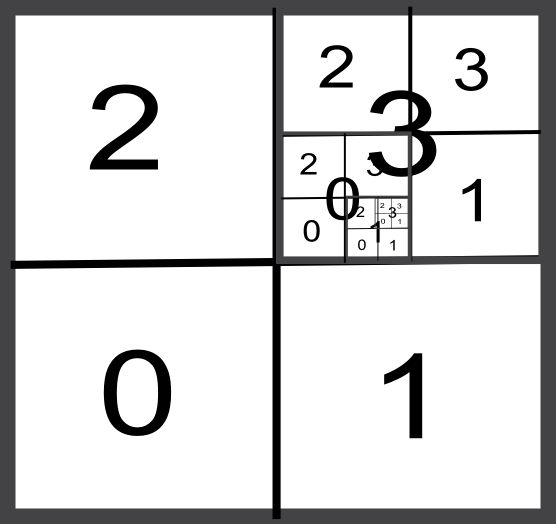Siguiendo con la dimensión fractal y definiendo sus coordenadas relativas lo mejor es empezar con un fractal de dimensión conocida, el fractal de Kock.
Following the study of the fractal dimension and defining their relative coordinates is best to start with a known fractal dimension, fractal de Kock
Para saber más, recomiendo ver: http://en.wikipedia.org/wiki/Koch_snowflake
Si se está interesado eh realizar este dibujo os dejo un programa sencillo para realizarlo:
To learn more, I recommend watching: http://en.wikipedia.org/wiki/Koch_snowflake
If you are interested in making this drawing I leave a simple program to do it:
Dim limi As Integer
Private Sub Command1_Click()
Picture1.ScaleHeight = 3
Picture1.ScaleWidth = 3
Picture1.Cls
For limi = 0 To 10
Dibu 0, 1, 3, 1, 0
SavePicture Picture1.Image, Trim(limi) & ".bmp"
DoEvents
Next limi
End Sub
Sub Dibu(ByVal a As Single, _
ByVal b As Single, _
ByVal c As Single, _
ByVal d As Single, _
ByVal prof As Integer)
If prof > limi Then DoEvents: Exit Sub
Picture1.Line (a, b)-(c, d), QBColor(prof + 1)
u = (c - a) / 3:v = (d - b) / 3
p = a + u:q = b + v:r = a + u * 2:s = b + v * 2:pr = r / 2 + p / 2
qs = q / 2 + s / 2
uprqs = r - p:vprqs = s - q
u = -vprqs * 0.866025403784439 + pr:v = uprqs * 0.866025403784439 + qs
Dibu a, b, p, q, prof + 1:Dibu p, q, u, v, prof + 1
Dibu u, v, r, s, prof + 1:Dibu r, s, c, d, prof + 1
End Sub
De la página web anteriormente mecionada tenemos el valor de la dimensión:
From the above mecionada website have the dimension value:
log 4/log 3 ≈ 1.26186
De las páginas nuestras anteriores podremos definir un punto de la forma:
From our previous pages can define a point of the form:
En donde cada valor A será un entero entre 1 y 4 (ó 0 y 3) sin un número real para moverse en el segmento final porque la secuencia anterior es infinita
Where each value to be an integer between 1 and 4 (or 0 and 3) without a real number to move into the final segment, it's because the above sequence is infinite.
En la figura superior: In the upper figure: OA = {(2, 1, 3, 3, ...)}
Cuando se añade un elemento más de la sucesión {0..3} (4 elementos nuevos), se decrementa la longitud en 1/3p. Resulta lógico que la dimensión fractal sea log(elementos nuevos)/log(razón de decremento) = log(4)/log(3) = 1.26186...
When an element of the sequence {0..3} (4 new items) is added, the length is decremented by
1/3p. It is logical that the fractal dimension is log (new items) / log (ratio decrease) = log (4) / log (3) = 1.26186 ...
En los casos anteriores de las tatispirales / In previous cases of tatispirales:
OA = {(0 .. ∞, 0 .. ∞, ..., 0 .. ∞p), 0 .. max_lp}.
max_lp = (R0/4p)·e-ksSAi es la longitud del elemento en el último punto de la sucesión del elemento "P". Si . Esto hace más difícil encontrar su dimensión / is the length of the element at the last point of the sequence of "P" element. therefore, it becomes harder to find your size.

.png)










